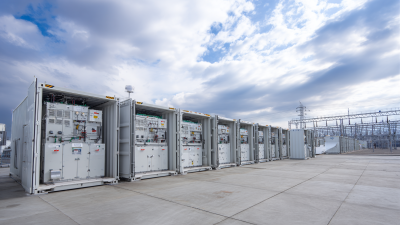What is UN3481 Lithium Ion Batteries and Why They Matter for Safe Shipping
In recent years, the rise of portable technology and electric vehicles has significantly increased the demand for lithium-ion batteries, notably those classified as UN3481. These batteries are essential components in powering devices ranging from smartphones to electric cars, and as their prevalence grows, so do the challenges associated with their transportation. According to the International Air Transport Association (IATA), in 2020 alone, the global air cargo transport of lithium batteries accounted for over 30% of total cargo volume, highlighting their critical role in global trade.
However, the shipment of UN3481 lithium-ion batteries involves specific regulatory requirements to ensure safety during transit. The United Nations has recognized these batteries as hazardous materials, necessitating compliance with stringent shipping regulations to mitigate risks such as fires and explosions. The 2021 edition of the UN Model Regulations emphasizes the importance of labeling, packaging, and documentation, which are crucial in transporting these batteries safely. Without proper adherence to these guidelines, the consequences can be catastrophic, underscoring the importance of understanding best practices for shipping UN3481 lithium-ion batteries effectively.

Understanding UN3481: What It Is and Its Classification
 UN3481 refers to a specific classification for lithium-ion batteries that are transported under certain conditions. This classification primarily applies to batteries being shipped in equipment, such as laptops and smartphones, or separately packed. The designation is crucial because it helps standardize the shipping process for these potentially hazardous materials, ensuring that they are handled with care during transport.
UN3481 refers to a specific classification for lithium-ion batteries that are transported under certain conditions. This classification primarily applies to batteries being shipped in equipment, such as laptops and smartphones, or separately packed. The designation is crucial because it helps standardize the shipping process for these potentially hazardous materials, ensuring that they are handled with care during transport.
Understanding UN3481 involves recognizing the regulations set forth by the United Nations for the safe transport of lithium-ion batteries. These regulations include packaging criteria that prevent leaks or fires, as well as specific labeling requirements that alert carriers and handlers to the presence of these batteries. Adhering to UN3481 regulations is essential for minimizing risks associated with shipping lithium-ion batteries, especially considering their susceptibility to overheating and combustion if damaged or improperly handled.
Importance of Lithium Ion Batteries in Modern Shipping
Lithium-ion batteries have become integral to modern shipping, powering diverse applications from consumer electronics to electric vehicles. According to a report by the International Council on Clean Transportation (ICCT), the global market for lithium-ion batteries is expected to reach $100 billion by 2025, highlighting their growing impact on the logistics and transportation sectors. The efficiency and energy density of these batteries make them the preferred choice for shipping companies aiming to reduce emissions and meet sustainability standards. However, their safe transportation, particularly under the UN3481 classification, is crucial to prevent hazards such as fires.
Tips: When shipping lithium-ion batteries, always ensure they are appropriately packaged and comply with the UN3481 regulations. Utilize sturdy, non-conductive materials to prevent short-circuiting, and always label packages clearly to inform handlers of their contents. Understanding these regulations not only ensures compliance but also enhances safety throughout the shipping process.
The importance of lithium-ion batteries extends beyond compliance; they are key to the transition toward greener technologies in shipping. The increasing demand for electric vessels and hybrid propulsion systems underscores the need for reliable battery technology. According to the Global Energy Storage Alliance, advancements in battery technologies could lead to a reduction in greenhouse gas emissions from shipping by up to 30% by 2030, emphasizing the critical role these batteries play in the industry's future.
Key Regulations Governing the Transportation of UN3481 Batteries
The transportation of UN3481 Lithium Ion Batteries is governed by a stringent set of regulations to ensure safe shipping. UN3481 refers specifically to lithium batteries contained in or packed with equipment, and these batteries pose unique risks during transit due to their potential for overheating and combustion. Key regulations include adherence to the Packaging Instruction 967 and 970 outlined by international transport authorities, which dictate specific requirements for labeling, packaging, and documentation. Understanding these regulations is critical for shippers to avoid violations that could lead to dangerous incidents.
Recent updates emphasize the need for comprehensive awareness regarding exemptions related to returning lithium batteries and the risks involved in shipping high-energy battery systems. The International Air Transport Association (IATA) has outlined essential protocols for safely navigating the complexities of shipping lithium batteries, especially by air. Moreover, regulatory changes set to take effect in 2025 and 2026 will introduce significant updates to existing guidelines, necessitating that shippers remain vigilant and informed about evolving standards to mitigate hazards effectively while maintaining supply chain integrity.

Safety Measures for Handling and Shipping UN3481 Batteries
Lithium-ion batteries, classified under UN3481 for transportation purposes, are increasingly vital in today’s technology-driven world, powering everything from smartphones to electric vehicles. However, their shipment presents significant safety challenges due to the risk of fire and explosion if not handled properly. According to a recent report, lithium-ion battery incidents have resulted in serious accidents in the past, underscoring the importance of adhering to stringent regulations during transport.
The International Air Transport Association (IATA) has established guidelines that mandate the use of specialized packaging solutions and appropriate markings on packages containing lithium-ion batteries to mitigate these risks.
In light of the changing regulatory landscape, such as the upcoming updates anticipated in 2025 and 2026, shippers must keep themselves informed about the evolving safety measures. Notably, the International Maritime Dangerous Goods (IMDG) Code classifies battery energy storage systems (BESS) as dangerous cargo, requiring careful adherence to shipping protocols. Recent guidelines emphasize the necessity of using UN-certified packaging and conducting thorough risk assessments before shipment. This proactive approach not only ensures compliance with international regulations but also promotes the safe transport of one of the most essential components of modern technology.
Potential Risks and Mitigation Strategies for Lithium Ion Batteries
Lithium-ion batteries (UN3481) are powerful energy sources commonly used in consumer electronics, electric vehicles, and renewable energy systems. However, their potential risks during transport cannot be overlooked. According to the International Air Transport Association (IATA), incidents involving lithium-ion batteries in transit have resulted in approximately 50 reported fires in cargo aircraft between 2006 and 2016. These occurrences highlight the importance of stringent safety measures during shipping to mitigate risks associated with battery damage, overcharging, or thermal runaway.
To address these challenges, various mitigation strategies have been proposed by industry experts. The Council on Safe Transportation of Hazardous Articles (COSTHA) emphasizes the necessity for proper packaging standards that can withstand extreme conditions. Adopting UN-approved packaging methods and implementing advanced battery management systems can significantly reduce the likelihood of failure during transport. Furthermore, adhering to regulatory guidelines, such as those outlined by the UN Manual of Tests and Criteria, ensures that lithium-ion batteries are transported securely, minimizing risks to human safety and the environment. As the demand for these batteries continues to rise, robust safety protocols will be essential to facilitate their safe shipping and usage.












